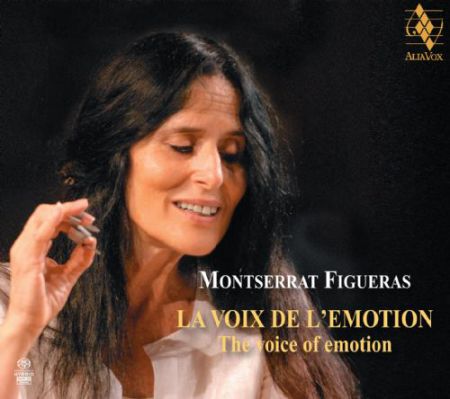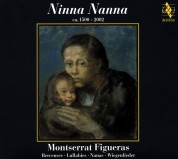The Voice of Emotion - SACD
700.00 TL
(KDV Dahil)
3 iş günü içerisinde kargoya verilir.
Ürün Hakkında
Barkod: 7619986398891
, Katalog No: AVSA9889 , Firma: Alia Vox
, Yayınlanma Tarihi:
2012
Tür:
Klasik Müzik
Format Türü: SACD, Format: 2 SACD
ENGLISH
This tribute album gathers highlights from <span data-scayt_word="Montserrat" data-scaytid="114">Montserrat</span> <span data-scayt_word="Figueras’" data-scaytid="115">Figueras'</span> career for the <span data-scayt_word="Astrée" data-scaytid="116">Astrée</span>, <span data-scayt_word="DHM" data-scaytid="117">DHM</span>, EMI and Alia <span data-scayt_word="Vox" data-scaytid="118">Vox</span> labels. 5 of the 35 tracks had already been reissued in a portrait album released in the <span data-scayt_word="90ies" data-scaytid="119">90ies</span> by <span data-scayt_word="Astree" data-scaytid="120">Astree</span> and already called "La <span data-scayt_word="Voix" data-scaytid="121">Voix</span> de <span data-scayt_word="l’emotion" data-scaytid="122">l'emotion</span> ". <span data-scayt_word="Jordi" data-scaytid="123">Jordi</span> <span data-scayt_word="Savall" data-scaytid="124">Savall</span> wanted to keep the same title for this much more comprehensive double album.<br /> By the early seventies, the need for a clear break with romantic tradition had been established, and it was now obvious that vocal Early Music needed a new stylistic and technical approach to vocal performance, similar to the one that was already being applied to its instrumental counterpart. This was the time when a few young singers involved in this search began to attract the attention of both critics and the general audience, and amongst them <span data-scayt_word="Montserrat" data-scaytid="136">Montserrat</span> <span data-scayt_word="Figueras" data-scaytid="137">Figueras</span> soon rose to be acclaimed as one of the most fascinating exponents of this new attitude.<br /> She was born in Barcelona, began her voice studies with <span data-scayt_word="Jordi" data-scaytid="138">Jordi</span> <span data-scayt_word="Albareda" data-scaytid="140">Albareda</span>, and at a very early age was already singing with the most prestigious Catalan Early Music ensemble, <span data-scayt_word="Ars" data-scaytid="141">Ars</span> <span data-scayt_word="Musicæ" data-scaytid="142">Musicæ</span>, performing the sacred works of the great Spanish <span data-scayt_word="polyphonists" data-scaytid="143">polyphonists</span> of the 16 century and of the songbooks of the Court of Charles V, that were to remain at the core of her musical background. In 1968 she married <span data-scayt_word="Jordi" data-scaytid="139">Jordi</span> <span data-scayt_word="Savall" data-scaytid="144">Savall</span>, and this was the start of an artistic 'as well as personal' association that has since then marked the evolution of the whole Early Music revival movement.<br /> As a student of the Schola Cantorum Basiliensis and of the local Musik Akademie, where she worked under Kurt Widmer, Thomas Binkley and later with Eva Krasznai, Montserrat Figueras had the opportunity of developing her general vocal training and of becoming acquainted with the latest research on original vocal techniques. The atmosphere surrounding these institutions was of the utmost importance... " was of the utmost importance to the personal growth of Montserrat as a singer. Most original treatises on the instrumental performance practice of the sixteenth, seventeenth and eighteenth centuries repeatedly stressed that the main goal of playing any musical instrument was to imitate as faithfully as possible the human voice, not only from the point of view of expression, but also in terms of the technical effects. Now, the only way to come up with a viable alternative to the established vocal patterns of the Romantic style of performance was to do exactly the opposite and search for similar approaches in the vocal realm to the one that performers of original instruments had by then already been able to develop. If the Florentine Camerata devised the new "stile recitativo" as a way of "imitare col canto chi parla", the goal was now, to some extent, that of "imitare col canto chi suona".<br /> This was probably one of the aspects that impressed me the most the very first time I attended a recital by Montserrat Figueras and Jordi Savall, some thirty-five years ago, at the Baroque chapel of Coimbra University. They were performing a Spanish "tono humano" from the seventeenth century, and the same musical phrase was circulating between the voice and the viol as if they both were but complementary elements of a single polyphonic instrument: we were all under the impression that Jordi's viol was literally singing, while Montserrat produced exactly the same effects of projecting the sound and articulating the phrases as if she possessed some miraculous way of transforming her vocal chords into bowed strings.<br /> Scholarly research and the study of instrumental performance were certainly essential references in the shaping of her personal approach to vocal Early Music, but perhaps even more important was yet another source of inspiration for her distinctive vocal style: her deep familiarity with the style of traditional singing in the folklore of her native Catalonia, in which so many aspects of centuries-old vocal techniques remained in use, often associated with melodies and dances that can also be traced back as far as the Late Middle Ages. And this familiarity was by no means restricted to her country's own tradition, but was accompanied by a constant interest in the global heritage of vocal music of the various Mediterranean cultures, from the Maghreb to the Balkans, and from the Near East to the French Midi.<br /> None of these different influences came from a purely intellectual design or through a merely academic endeavour. Montserrat Figueras absorbed them, first of all, through her natural perceptiveness and incorporated them quite naturally into her instinctive musicianship, thus achieving a perfect blend that unifies all of her performances into an unmistakably personal style, whether she is singing a Sephardic song, a Monteverdi madrigal or an Early-Romantic "canzonetta" by Sor. And this is certainly the reason why she can follow the strictest working discipline in the preparation of every single piece without ever losing the spontaneous approach which characterizes each of her performances.<br /> In fact, although I am convinced that all the aspects that I have pointed out are definitely relevant for the understanding of the background of Montserrat's artistry, I should stress that none of them can begin to explain or even simply describe the essence of her impact upon the listener, especially in a live concert. She is, of course, strikingly beautiful, and her mere presence on stage surrounds her with an aura of both intense sensuality and aristocratic grace. And these two qualities become even more evident in her singing, to which she commits body and soul, mind and emotion. Her whole body seems to vibrate with the dance rhythms of a song. Her face becomes the mirror of the emotional tension of each text, conveying joy and sorrow, desire and devotion, passion and melancholy, excitement and serenity.<br /> The same can be said of her voice. With its unique blend of warmth and transparency, it can support the whole gamut of human emotion, while expressing each nuance of the meaning of the poem. Furthermore, although it does not seem to be particularly powerful, it projects so well that even in a large cathedral it carries wonderfully from the main altar to the last benches at the end of the nave.<br /> She has now performed all over the world, usually with Hespèrion XX, the extraordinary ensemble she has founded in 1974, together with her husband, Jordi Savall, and with wind instrument player Lorenzo Alpert and lutenist Hopkinson Smith, or, in the last few years, with the vocal ensemble La Capella Reial de Catalunya. Her countless records have been awarded the most prestigious prizes in the field of Classical Music. Imitated by many, she remains the standard by which her colleagues arc judged.<br /> It is therefore only natural that she should be the subject of a personal compilation such as the present double album, covering the different areas of the repertoire in which she excels, from the Sephardic songs and the haunting prophecies of the Sibil·la to the Iberian polyphonic songbooks of the Renaissance and the charming melodies of the Spanish vihuela repertoire, from the intense devotional atmosphere of the masterworks of Guerrero and Victoria to the exquisite accompanied monodies of Monteverdi and Merula, from the charm and the rhythmic energy of the "tono humano" of the Spanish Early Baroque to its later equivalent of the time of Goya and the Napoleonic Wars, at the dawn of Romanticism. For those who already love Montserrat Figueras, this album serves as a carefully and lovingly organized sample of her career and of her music. For those who will discover here, for the first time, the wisdom and the emotion that are inherent in her voice and in her artistry, I am certain that this will be an unforgettable moment of discovery of the most genuine and fascinating talent in the world of Early Music today.<br /> RUI VIEIRA NERY<br /> Universidade Nova de LisboaEser Listesi
- CD: 1
- Anonim
- CD: 2
- Anonim
- Anonim
- Anonim
- Anonim
- Anonim
Katkıda Bulunanlar
|
|
Bu Ürünler İlginizi Çekebilir















